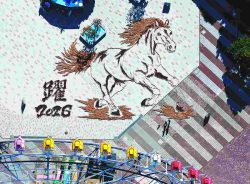
A raft is seen skillfully passing through the famous Kotaki-no-Se rapids behind the Iwadatami metamorphic rock formation, whose surface shimmers in the sunlight in Nagatoro, Saitama Prefecture.
17:54 JST, December 15, 2020
NAGATORO, Saitama — The huge metamorphic rock formation, with steps here and there, looks like countless tatami mats in layers covering the large area. This formation, called Iwadatami (rock tatami), stretches more than 500 meters on the west bank of the Arakawa river in Nagatoro, Saitama Prefecture.
This magnificent view is just as I saw in a guidebook, with one exception: on arriving here, I discovered that its shining surface varies greatly, depending on how the sunlight hits it.
The beautiful gorge in Nagatoro, including this rock formation, was created 70 million to 80 million years ago when crystalline schist, formed under high pressure 20 to 30 kilometers below the ground, was uplifted.
This place is renowned as a “window into the Earth,” because rocks once deep underground miraculously appeared on the surface. Researchers have been visiting this area since the early Meiji era (1868-1912), as they thought they would able to look into the Earth to learn more about it.
Crystalline schist, which looks like mille-feuille, is usually formed of mica and other slate-like minerals and has a reflective surface.
I took a boat from upstream on the river to view the rocks from the water. The river flows slowly, starting from around the Iwadatami formation. This is why this area is named Nagatoro, the boatman told me. “Naga” means long and “toro” means a gentle river flow, so Nagatoro refers to a long gentle stretch of the river.
The color of crystalline schist varies depending on the type of contained minerals. Here in Nagatoro, greenschist particularly caught my eye. The surface of the gentle river is also greenish, making it a poetic scene for me.
On Oct. 15, 1930, the local Chichibu Railway Co. invited the renowned haiku poet Kyoshi Takahama and his second daughter, Tatsuko Hoshino, also a haiku poet, and some others for a one-day trip to Nagatoro. The group visited Nagatoro and enjoyed a river cruise. They also landed on the rock formation and wrote haiku poems.
In 1953, Chichibu Railway planned to build a stone monument with an inscribed Kyoshi’s haiku in Nagatoro. The company sent a photo of the stone piece for the monument taken from the river to the haiku poet’s home in Kamakura, Kanagawa Prefecture. On Sept. 16 that year, Kyoshi wrote a haiku, which reads, “Kokoni ware ku o todomubeki tsuki no ishi” (I leave my poem here, on a moon stone).
The monument was set up a little upstream of the rock formation. That area is called Tsuki no Ishi Momiji Koen (Moon Stone Maple Park).
I presume Kyoshi depicts in the poem the rock formation shining in the moonlight.
“I’ve seen the layered rock shine so mystically several times in the past. At these times, I was moved so much,” said Yoshiaki Inoue, 65, who was born and raised in Nagatoro in a family that runs a business on a local shopping street. “I’m amazed at Kyoshi’s insight into the charm of the rock.”
For the ultimate effect of the Iwadatami rock, I newly discovered, you must come here during a full moon and stay overnight.
■ Kenji inspired by tiger rock’s pattern

A stone monument stands with an inscribed tanka poem by Kenji Miyazawa near the riverbank of the Toraiwa rock.
Near the stone monument with Kyoshi’s poem at the Moon Stone Maple Park, there is a monument honoring Kenji Miyazawa, a popular poet and writer, in the shade of the greenery near the riverbank. This monument is inscribed with a tanka poem by Kenji.
When he was a student at the Morioka Imperial College of Agriculture and Forestry (present-day Iwate University Faculty of Agriculture), Kenji visited this area in 1916 to conduct a geological survey. At that time, he saw the Toraiwa (tiger rock), named so because its appearance is similar to tiger fur. The rock is formed by layered dark brown and white minerals with a beautiful striped pattern. Kenji was so impressed that he compared it to Hakata-obi, a kimono sash made with distinctively patterned Hakata-ori woven cloth.
Masashi Noguchi, 78, a local historian, served as my guide and took me to the Toraiwa rock. We walked through a wooded area behind the tanka monument down to the riverbank to reach the rock.
Once we reached the bank, Noguchi pointed upstream. There I saw Chichibu Railway’s Arakawa Bridge, which was opened two years before Miyazawa’s visit to Nagatoro. Its piers, formed with stacked bricks, tell its history.
“I used to work for Chichibu Railway as a conductor for many years,” said Noguchi. Then, in a sonorous voice, he demonstrated the on-board announcements he had made each time a passenger train was entering the bridge.
“You can see the clear stream of the Arakawa river below. The water source of this river is Mt. Kobushi, which is the main peak of the Oku-Chichibu. The Nagatoro Iwadatami is about one kilometer downstream from here.”
I saw a freight train full of limestone mined in the Chichibu Mountains crossing the bridge. Kenji also may have seen a train crossing this bridge when he visited the tiger rock more than 100 years ago, I thought.
Scientists believe the Chichibu Basin, including Nagatoro, was the seaside around 15 million to 17 million years ago. The numerous fossils of Paleoparadoxia, an extinct mammal living around that time, have been unearthed here. This was a mysterious animal that resembled a hippopotamus but was taxonomically very different.
In 1988, Chichibu Railway started a sightseeing train pulled by a steam locomotive. The train service was named Paleo Express after this mysterious animal. When Noguchi was still active, working on this train was “the most enjoyable,” he said.
The train service is suspended from operation this year in order to conduct inspections. I yearn to come back here again and ride on it.

The skeletal fossil of Paleoparadoxia is on display at the Saitama Museum of Natural History in Nagatoro, Saitama Prefecture. It was discovered in 1972 in Chichibu in the prefecture.
"Society" POPULAR ARTICLE
-

M4.9 Earthquake Hits Tokyo, Neighboring Prefectures
-

M7.5 Earthquake Hits Northern Japan; Tsunami Waves Observed in Hokkaido, Aomori and Iwate Prefectures
-

Tsukiji Market Urges Tourists to Avoid Visiting in Year-End
-

Israeli Tourists Refused Accommodation at Hotel in Japan’s Nagano Pref., Prompting Protest by Israeli Embassy and Probe by Prefecture
-

M5.7 Earthquake Hits Japan’s Kumamoto Pref., Measuring Upper 5 Intensity, No Tsunami Expected
JN ACCESS RANKING
-

Keidanren Chairman Yoshinobu Tsutsui Visits Kashiwazaki-Kariwa Nuclear Power Plant; Inspects New Emergency Safety System
-

Imports of Rare Earths from China Facing Delays, May Be Caused by Deterioration of Japan-China Relations
-

University of Tokyo Professor Discusses Japanese Economic Security in Interview Ahead of Forum
-

Japan Pulls out of Vietnam Nuclear Project, Complicating Hanoi’s Power Plans
-

Govt Aims to Expand NISA Program Lineup, Abolish Age Restriction























